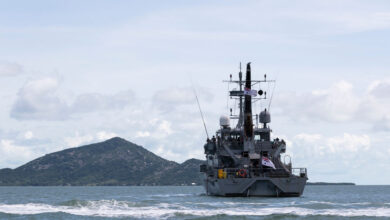Draft PRC law raises conflict risk in South China Sea, experts warn

FORUM Staff
Chinese legislators have drafted a law that would give the People’s Republic of China’s (PRC’s) coast guard permission to fire upon foreign vessels in disputed waters of the South China Sea, ratcheting up tensions in an already contested environment.
The proposed law from the National People’s Congress says the coast guard would be allowed to use “all necessary means” to prevent threats from foreign vessels in the PRC’s “jurisdictional waters,” some of which are claimed by other countries.
One defense scholar called the legal gambit an intimidation ploy. The Chinese Communist Party “is trying to tell other claimant governments that China means business,” said Hunter Stires, a fellow at the U.S. Naval War College, according to Radio Free Asia (RFA). “This is a signal not to challenge China coast guard operations in waters that are rightfully the exclusive economic zones of Southeast Asian nations.”
The law is also likely designed to appeal to a domestic Chinese population who have grown up under an education system that stresses sovereignty over the peripheries of Chinese territory, including much of the South China Sea. For example, PRC citizens are taught that the most southern point of China is James Shoal — a submerged feature 80 kilometers north of Malaysia and 1,770 kilometers from mainland China. To ensure its legitimacy internally, Beijing must demonstrate to a very patriotic population that it can defend the areas it has declared to be Chinese territory.
Another defense scholar said the legal move raises the risk of conflict. “This will be the first time that the coast guard is given power, explicitly by law, to use weapons in disputed waters,” said Zhang Mingliang, associate professor at the School of International Studies at Guangzhou-based Jinan University, Bloomberg reported. “This will definitely complicate an already tense situation in the South China Sea.”
The proposed law, which is open for public comment until December 3, 2020, says the coast guard and other maritime agencies can use small arms or shipborne weapons, such as deck-mounted guns, when encountering vessels acting illegally in the PRC’s jurisdictional waters. The law does not define jurisdictional waters, which raises questions about the measure’s compliance with international law.
The PRC has attempted to exercise jurisdiction as far away as Fiery Cross Reef in the Spratly archipelago in the South China Sea. Its coast guard arrested suspected drug traffickers there in September 2020, despite the PRC not having economic or legal rights to those waters, RFA reported. While militarized and controlled by the PRC, the waters are also claimed by the Philippines and Vietnam.
An international tribunal soundly rejected much of the PRC’s maritime claims in the South China Sea in July 2016, finding that they had no basis in international law. The PRC’s maritime claims overlap with the exclusive economic zone (EEZ) claims of Brunei, Indonesia, Malaysia, the Philippines, Taiwan and Vietnam.
The United States in July 2020 published a legal position paper that aligns with the tribunal’s ruling. U.S. Secretary of State Mike Pompeo said in a news release that the PRC cannot lawfully assert a maritime claim in areas near Scarborough Shoal and the Spratly Islands, for example, because the tribunal found they are in the Philippines’ EEZ. He said the PRC also has no lawful claim to Mischief Reef or Second Thomas Shoal, which are in the Philippines’ jurisdiction. (Pictured: A People’s Republic of China coast guard vessel patrols disputed waters near Scarborough Shoal in April 2017.)
“The world will not allow Beijing to treat the South China Sea as its maritime empire,” Pompeo said. “America stands with our Southeast Asian allies and partners in protecting their sovereign rights to offshore resources, consistent with their rights and obligations under international law.”




